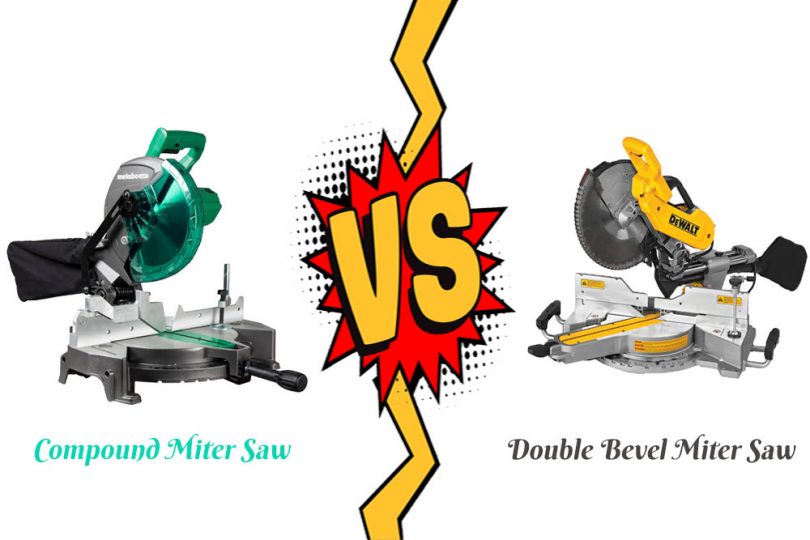The key difference between the two is, the blade of a compound miter saw can only tilt on one side while the double bevel miter saw can cut bevels from both left and right.
Compound vs Double Bevel Miter Saw
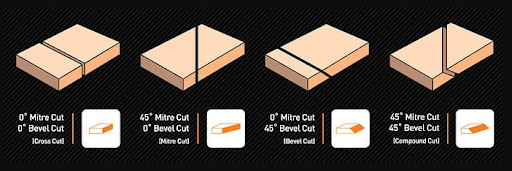
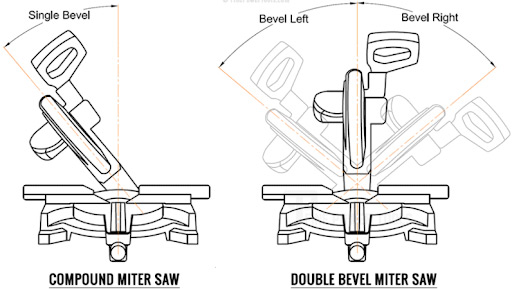
Key differences at a glance
| Comparing points | Compound miter saw | Double bevel |
| Constructions | Can only tilt in one side | Can tilt in both sides |
| Cutting methods | Both miters and bevels | Both miters and bevels |
| Bevel cuts | Only on one direction | From both directions |
| Working space | Less space needed | More space needed |
| Price | Relatively cheaper | Relatively expensive |
| Time | Need more time to finish work | Comparatively less time needed |
| Versatility | Less versatile | More versatile |
| Malfunctioning | Risk of malfunctioning in work is higher | Risk of malfunctioning in work is less |
| Usability | Simple to use | A little bit complex in function |
| Weight | Comparatively lower | Comparatively higher |
| Mobility | Highly portable | Lower portability |
| Training | Require less training | Require more training |
What’s a Compound Miter Saw?
A compound miter saw is a single bevel miter saw that allows you to cut 45 degrees to the left.
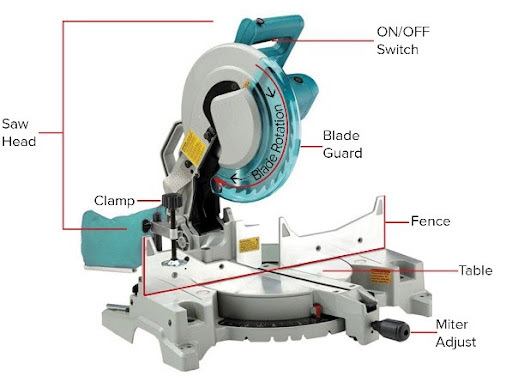
The reason people call them compounds is that they can cut both the miters and the bevels.
The scale on the base lets you see the miter position in degrees when you rotate the blade.
The blade of a compound miter saw hinges for 90° (angled) cuts and tilts in one particular direction for beveled slices.
The compound miter saw is known to be the most straightforward type. Its rotating table allows you to cut pieces in diverse miter angles.
You’ll have no issue cutting miters or bevels of any kind with its potent motor, tall sliding fences, and stainless-steel detent plate.
Pros
Simple to use is the first advantage of the compound miter saw. They are sturdy tools and precise in cuts.
These saws take up less space on your working site. You can put them in a tight place and keep the workflow running.
You’ll find the single bevel compound miter saw reasonable in price compared to the double bevel ones.
Cons
On the downside, you’ll see the compound miter saw lacking in versatility. As it tilts only in one way, you may have to turn the boards over and over again to get a cut.
It does not allow you to reverse cut your pieces as the risks of malfunctioning will be much higher.
Uses of Compound Miter Saw
The compound miter saw is excellent for square, beveled, or angled cuts.
The tool’s undeniable accuracy for crosscuts on wood makes it still the best for molding crowns and other such operations where you need precise but complex and compound cuts.
Using a compound miter saw is great for
- Cutting the long boards in pieces really quick and easy
- Making regular crosscuts
- Angled and miter cuts
- Compound angle cuts
- DIY projects like flooring and remodeling
- Trimming
Double Bevel Miter Saw
A double/dual bevel miter allows you to keep your piece in one spot and alter the angle of the saw instead of repeatedly maneuvering your material.
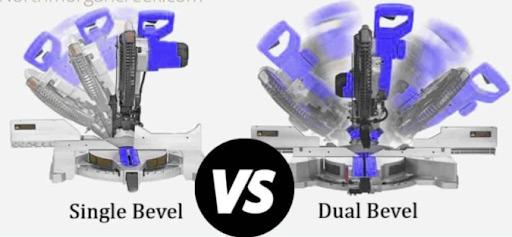
The double bevel miter saw includes a miter table, sliding rails, and the ability to make swift bevels at any angle.
They can cut up to a 48-degree angle from both directions quite well.
The angled cuts from a dual bevel miter saw would match up nicely to help you with trim molding and framing works.
You can cut from every wished angle possible without having to frequently replace or flip the materials from one side to the other.
Pros
As we think of a dual bevel miter saw, a very compact and versatile tool comes to mind.
These saws can cut bevels from left and right without putting you through the hassle of reversing the work, which saves you a lot of time.
They are mostly made of metal but are lightweight tools. A regular person can carry them without much effort.
You can even put them in the trunk of your four-door vehicle.
Cons
The double bevel miter saw has fewer drawbacks as compared to a compound miter saw.
Having additional features makes the tool slightly more expensive. Since they can make cuts from both sides, more working space is required.
Uses of Double Bevel Miter Saw
A dual bevel miter saw lets you unleash the beauty of all your creativity; like if you can think the cut it can make it.
- Regular Crosscuts
- Construction and Carpentry
- Miter cuts for casing and framing
- Easy Bevel cuts for setting the materials together
- Compound cuts to match the materials right in tricky positions
- Next-level DIY works
Know About the Cuts

Miter Cut
Swipe the miter handle to block it at 45 degrees, place the board tight to the fence and table, and spin the saw to make a miter cut. Miter cut is for door and window casing, picture frames, or any material that needs to come together at an angle.
Bevel Cut
Loosen the bevel handle, tip the head tight to 45 degrees, place the board down pushing to the fence and you’ll be good to get your 90-degree bevel cut. Cutting bevels can be tricky with wider boards, so clamp them down real tight. Bevel cuts are for baseboards or any other material that needs to come together at a particular angle. This cut is particularly useful when you need to match up the pieces in an inside corner.
Compound Cut
The compound cut is known as the most complicated one. It includes a miter and a bevel altogether which you often see in crown molding. To make the compound cut, adjust your miter handle to 45 degrees, loosen the bevel handle to lock the tip at 45 degrees, get the material rightly placed, and then rip the cut.
Some Beginner Tips at a Glance
- Put on eyewear. You don’t want sawdust entering your eyes.
- Always keep the piece/board tight to the fence for your safety.
- The Amount of Amps indicates the motor power. More Amps mean more power for your saw.
- Consider blade size as you choose your miter saw. 8’’, 10”, and 12” are the most common saw blade sizes. Larger blades make longer cuts.
- Count teeth per inch on the saw blade. More teeth mean finish cuts; choose fewer teeth for rough cuts.
- Get a saw that quickly stops to save you time as you work.
- Articulated blade guard and trigger locking feature make you concentrate on the cutting line better.
- Clearly marked scale and solid detent preset give you a better viewpoint.
- Get the one with strong fence support for your piece and smooth gliding action.
- The electric brake is a good feature to have. It stops your blade within two seconds.
- Use table extensions to cut longer stocks accurately.
- Look for sliding and flip fences to make standard miter cuts and bevel cuts on the taller stocks.
- Laser lines and LED shadow guides help you with precision.
- Modern display on your saw makes your bevel and miter setting easy.
- Think of your convenience for dust collecting ports and their location.
- Use a vacuum with the included vac port to minimize dust as much as possible.
Compound Vs. Double Bevel Miter Saw: Which one is for you?
If you are a homeowner or a DIY enthusiast or you want a miter saw that operates in less space, it’s good to save some bucks and go for the Compound miter saw. For professionals or someone looking to have the absolute hike of the board cutting experience, a double bevel miter saw is the way to go.
FAQs
1. Is a dual bevel necessary?
Ans: No, it’s not necessary but if you don’t like to reposition your workpiece for every cut, choose a dual bevel miter saw.
2. What is the difference between miter and bevel?
Ans: Simply put, a bevel is a 45-degree slope at the surface of the material. A miter is naturally an angled cut (45-degree) on any piece/board. Since they are very different cuts but drawn to serve similar goals, they (bevel and miter) are tricky to recognize at a first glance. Watch some close pictures to drop off the confusion.
3. Can I use a miter saw as a table saw?
Ans: No, you can’t, for they have different characteristics. A miter saw cannot make rip cuts which is the crown for a table saw. The miter saw is pushed down on board to cut, but the blade of a table saw rises from beneath to cut the piece. When it comes to the type of cuts, the miter saw wins but cannot handle long cuts and large planks like a table saw.
4. What do you use a compound miter saw for?
Ans: A compound miter saw is perfect for almost any type of crosscut including angled, beveled, or square cuts. You can also use it for compound cuts (angled+beveled)

